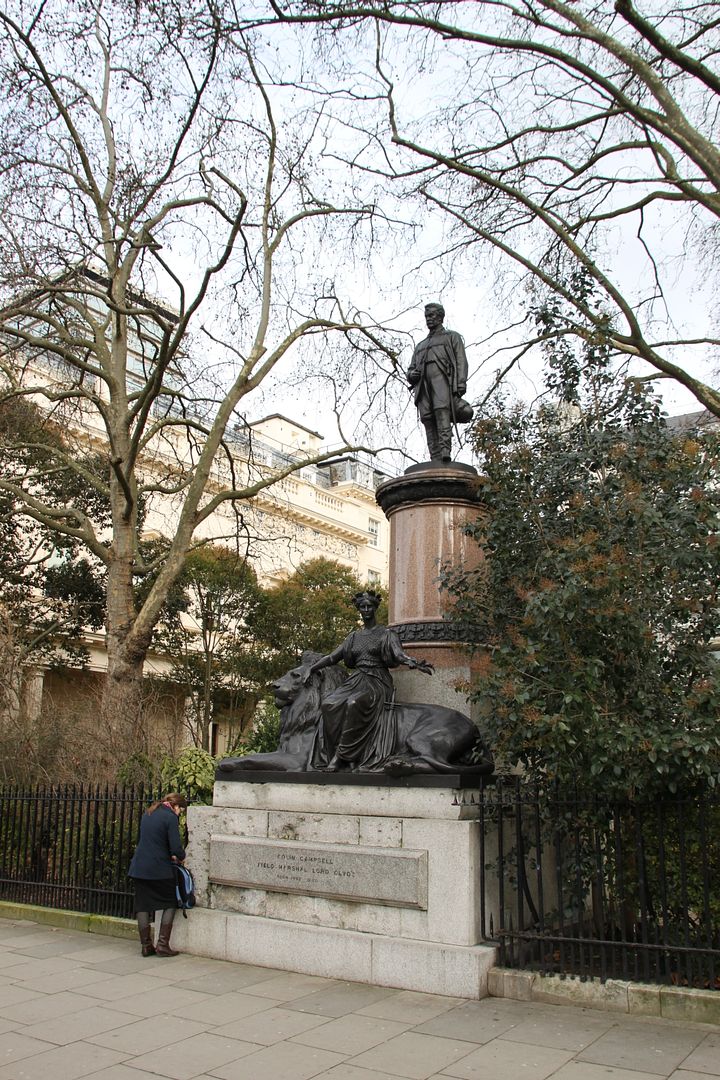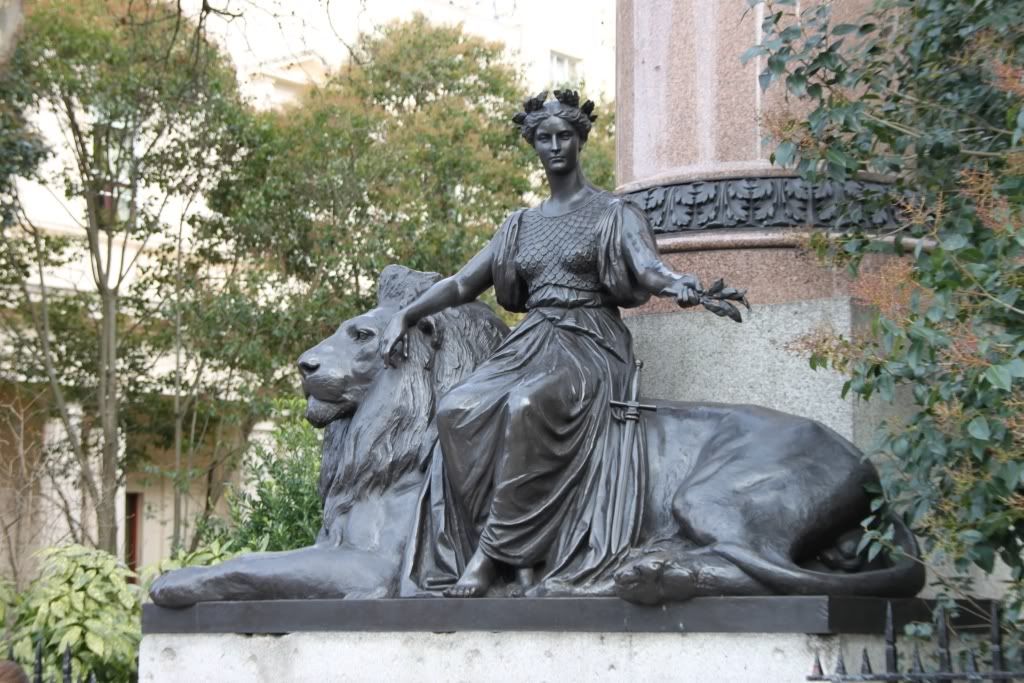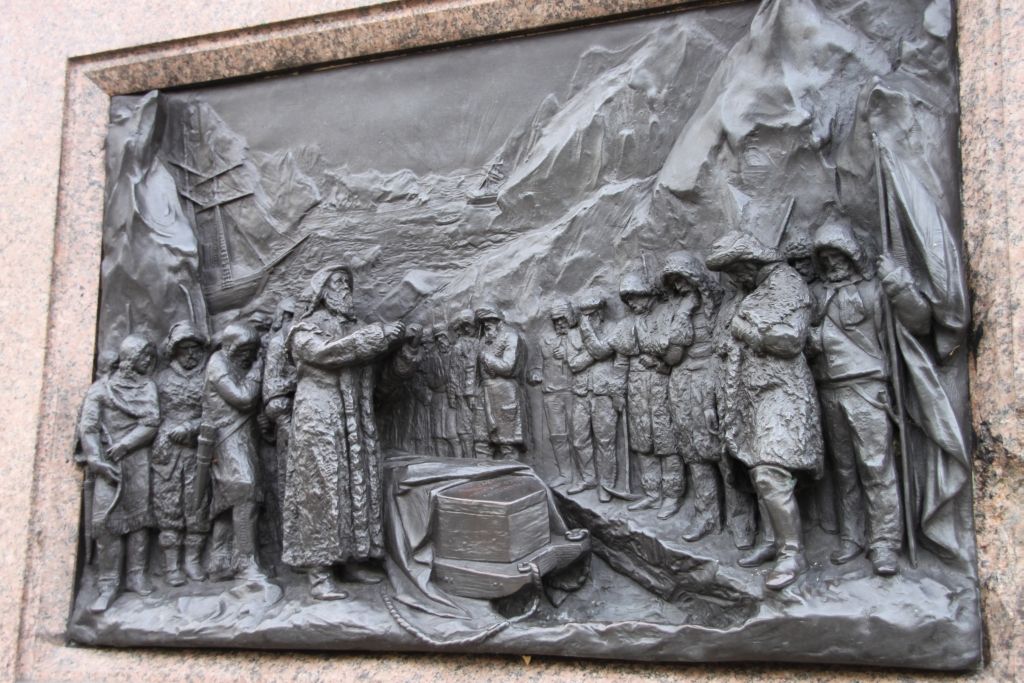We were out taking photographs on our monthly photo walk in the centre of town. I was walking from the Serpentine back to the Patisserie Valerie where couple of large moist pastries and a hot chocolate were calling for me. But on the way, I saw several statues and decided to take some photographs. Only few of the photographs are shown here, rest of them are up on this slide show here.

First you have two statues of King George VI and Queen Elizabeth his wife, the Queen Mother. King George was the last Emperor of India, the Last King of Ireland, the first Head of the Commonwealth and the father of the current Queen Elizabeth II. His wife, Queen Elizabeth was much loved and she died in 2002. Lovely lady she as too. King George seems to have had an extraordinary life (do see the wiki article), he was never expected to gain the throne, was in the Royal Navy during WW1 and then was destined to be one of the lesser Royals. Till his brother, Edward VIII abdicated in 1936 over his love for Wallis Simpson and he was pitch forked straight into the throne and World War II. He lived through perhaps the most traumatic times for the British Royalty between the World War and losing most of the major Empire possessions till he died in 1952 when the current Queen took over.

Then for some reason looked up and saw this strange statue perched on top of the building.

Its actually another statue on top of a whacking big column of Frederick, Duke of York, 1763-1827, the second son of King George III, Commander of the British Army twice over. After researching more about him, I think he is a pretty good egg despite the doggerel which was written for him after he made a hash of his first army command. I didn't realise this doggerel was for this fella.
He was responsible for the establishment of Sandhurst, the UK’s military college where commissioned officers are trained. He also fully reorganised the chaotic state of the British Army. One can really argue that he laid the foundations of the success that Wellington and Nelson finally achieved by defeating Napoleon’s French forces. But since his work was organisational, training, administrative, pay and policies, it is not that well known. But the soldiers did know who was to thank for their betterment and each soldier gave up one day’s salary to fund this statue. By the way, he is also in the Guinness Book of Records as the youngest bishop at 196 days old. Go read the wiki link on this amusing interlude
 Once you have climbed up the stairs below Fredrick’s column, you reach Waterloo Place and all the statues that I speak of below are in this square.
Once you have climbed up the stairs below Fredrick’s column, you reach Waterloo Place and all the statues that I speak of below are in this square.
 This is a statue of John Lawrence, the 1st Baron Lawrence. He was the Governor of the province of Punjab when the first war of Independence / Mutiny of 1857 broke out, he lead the troops who liberated Delhi from the rebels. Curiously enough, he also tried his level best to stamp out the practise of Sati and was quite concerned about the state of the Indian peasantry. He also made a treaty with Dost Mohammad of Afghanistan, and then went back to the UK. But he was back in India in 4 years to become the Viceroy till 1869. This statue was raised by public subscription from both British and Indian citizens. Hmm, curious.
This is a statue of John Lawrence, the 1st Baron Lawrence. He was the Governor of the province of Punjab when the first war of Independence / Mutiny of 1857 broke out, he lead the troops who liberated Delhi from the rebels. Curiously enough, he also tried his level best to stamp out the practise of Sati and was quite concerned about the state of the Indian peasantry. He also made a treaty with Dost Mohammad of Afghanistan, and then went back to the UK. But he was back in India in 4 years to become the Viceroy till 1869. This statue was raised by public subscription from both British and Indian citizens. Hmm, curious.
 The next statue is that of Colin Campbell, Field Marshall Lord Clyde, 1792-1863. He seems to have fought all over the world, Europe, USA, India and Crimea. He was the man who relieved the Lucknow siege and was responsible for the overall command of British Forces in India. Two soldiers, both connected to India.
The next statue is that of Colin Campbell, Field Marshall Lord Clyde, 1792-1863. He seems to have fought all over the world, Europe, USA, India and Crimea. He was the man who relieved the Lucknow siege and was responsible for the overall command of British Forces in India. Two soldiers, both connected to India.
 The statue of Colin Campbell is fronted by a lissom statue of Britannia sitting on a lion.
The statue of Colin Campbell is fronted by a lissom statue of Britannia sitting on a lion.
 The next statue is that of Robert Falcon Scott. Every time I read about him or his story, I feel so sad about him. Extreme bravery and ultimate failure, dying in the midst of the snow deserts of Antarctica from exhaustion, hunger and extreme cold. He wanted to be the first person to reach the South Pole, but he was beat out of this record by Roald Amundsen. Here he is wearing Antarctica winter clothing. The plaque below the statue states: Robert Falcon Scott. Captain Royal Navy who with four companions died march 1912 returning from the South Pole 'Had we lived I should have had a tale to tell of the hardihood endurance and courage of my companions which would have stirred the heart of every Englishman but these rough notes and our dead bodies must tell the tale.' — From Scott's Diary. Interestingly enough and quite uniquely, I must admit, it was his wife who sculpted this statue.
The next statue is that of Robert Falcon Scott. Every time I read about him or his story, I feel so sad about him. Extreme bravery and ultimate failure, dying in the midst of the snow deserts of Antarctica from exhaustion, hunger and extreme cold. He wanted to be the first person to reach the South Pole, but he was beat out of this record by Roald Amundsen. Here he is wearing Antarctica winter clothing. The plaque below the statue states: Robert Falcon Scott. Captain Royal Navy who with four companions died march 1912 returning from the South Pole 'Had we lived I should have had a tale to tell of the hardihood endurance and courage of my companions which would have stirred the heart of every Englishman but these rough notes and our dead bodies must tell the tale.' — From Scott's Diary. Interestingly enough and quite uniquely, I must admit, it was his wife who sculpted this statue.
 Then we have a rather pedestrian statue of Edward VII, son and successor of Queen Victoria.
Then we have a rather pedestrian statue of Edward VII, son and successor of Queen Victoria.
The Edwardian era of British History is so named after him. He was king from 1901 to 1910.

 The next statue is that of Sir John Franklin, 1786-1847, who was an explorer and a British Royal Navy Officer. He had a good career during the wars with France (Copenhagen and Trafalgar) and spent a significant time exploring Australia and Canada in the Arctic regions. He is also said to be the discoverer of the North West Passage in Canada, but this last voyage of his is shrouded in mystery as both his ships (Erebus and Terror) were lost and his entire crew died.
The next statue is that of Sir John Franklin, 1786-1847, who was an explorer and a British Royal Navy Officer. He had a good career during the wars with France (Copenhagen and Trafalgar) and spent a significant time exploring Australia and Canada in the Arctic regions. He is also said to be the discoverer of the North West Passage in Canada, but this last voyage of his is shrouded in mystery as both his ships (Erebus and Terror) were lost and his entire crew died.
 The last statue on this side is that of John Fox Burgoyne, 1782-1871, a distinguished soldier who saw action in Spain, France, USA, Portugal, Ireland and Crimea.
The last statue on this side is that of John Fox Burgoyne, 1782-1871, a distinguished soldier who saw action in Spain, France, USA, Portugal, Ireland and Crimea.
 Then we have this horse block, something that people used to climb on top of their horses. The plaque says that this was erected by the Duke of Wellington in 1830. Very curious.
Then we have this horse block, something that people used to climb on top of their horses. The plaque says that this was erected by the Duke of Wellington in 1830. Very curious.

 Then we have the Crimea Monument. This was built in 1861 to commemorate the Crimean War, cast in bronze from the cannons captured at the siege of Sebastopol. There are three Guardsmen in the front and there is a pile of cannon in the back. These are the actual Russian guns captured in that horrible war. The Crimean War was frankly one of the most horrible, badly managed and perhaps pointless wars of all times. This is the war which had the Charge of the Light Brigade and also saw the work of Florence Nightingale, the first use of the telegraph and railways in a military sense plus extensively photographed for the first time. On the top is an allegorical figure of Honour or Liberty. But God knows there was very little honour or liberty in that war.
Then we have the Crimea Monument. This was built in 1861 to commemorate the Crimean War, cast in bronze from the cannons captured at the siege of Sebastopol. There are three Guardsmen in the front and there is a pile of cannon in the back. These are the actual Russian guns captured in that horrible war. The Crimean War was frankly one of the most horrible, badly managed and perhaps pointless wars of all times. This is the war which had the Charge of the Light Brigade and also saw the work of Florence Nightingale, the first use of the telegraph and railways in a military sense plus extensively photographed for the first time. On the top is an allegorical figure of Honour or Liberty. But God knows there was very little honour or liberty in that war.
 In front of the Crimea monument are two statues. On the left is Florence Nightingale holding a lamp and on the right is Sidney Herbert who was the Secretary of War during the Crimea War. So we come to the end of the essay about some Victorian Era (mostly) hero’s whose statues are in this small corner of London. I stood there and slowly revolved around looking at the various emperors, captains, generals and field marshals. Their exploits have made a massive difference to the world I live in, and I stand here looking at their stone and bronze statues so many moons later. Here is the full slide show with higher resolutions and more photographs.
In front of the Crimea monument are two statues. On the left is Florence Nightingale holding a lamp and on the right is Sidney Herbert who was the Secretary of War during the Crimea War. So we come to the end of the essay about some Victorian Era (mostly) hero’s whose statues are in this small corner of London. I stood there and slowly revolved around looking at the various emperors, captains, generals and field marshals. Their exploits have made a massive difference to the world I live in, and I stand here looking at their stone and bronze statues so many moons later. Here is the full slide show with higher resolutions and more photographs.

No comments:
Post a Comment